Air mattresses can serve a number of useful functions. They can provide a comfortable place for guests to sleep, upgrade camping to “glamping,” and so on. But some people don’t feel comfortable or have the mobility required to sleep close to the floor. That’s where air mattresses with frames come in: The frames allow the bed to sit closer to a standard bed’s height, which can make it easier to get in and out of bed and provide something closer to a traditional sleeping experience.
How do you settle on the best air mattress with frame? It helps to consider a number of factors, including the mattress size that you want, the amount of storage space available, your budget, and whether you want extra features such as side tables, a carry or storage case, and so on. Then check out our roundup to get started on your search!
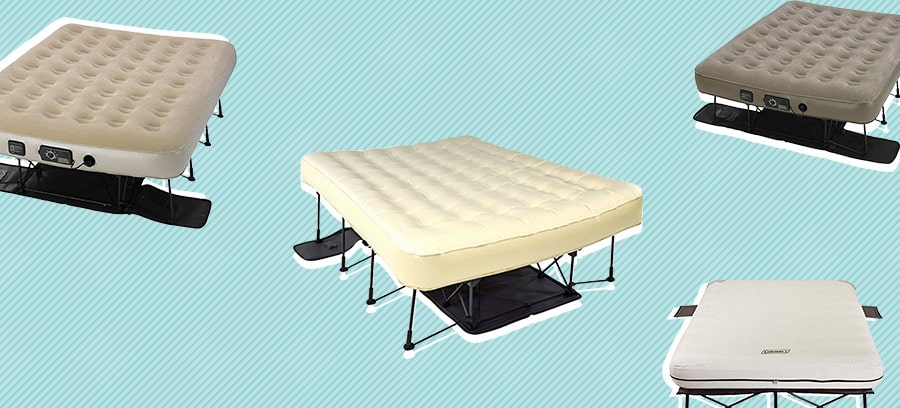
Editor’s Choice
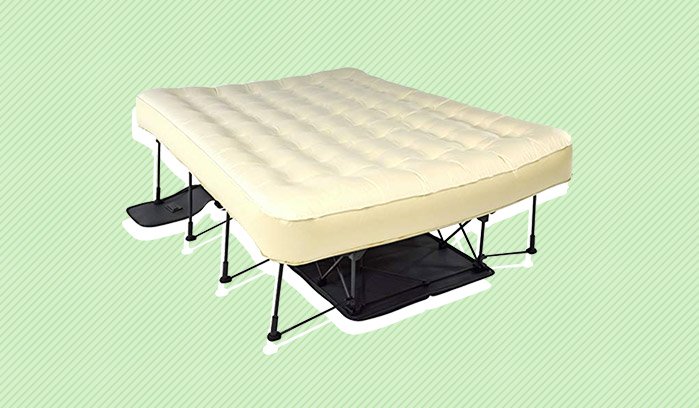
Ivation EZ-Bed Air Mattress with Frame & Rolling Case
Pros:
- The included pump is designed to inflate and deflate the air mattress in under four minutes.
- The air pump has auto shut-off options for different firmness levels (Plush, Medium, and Firm).
- The air mattress has a coil design to provide support and some body contouring.
- The bed comes with a duffel bag for compact storage.
Cons:
- This is a pricey product that won’t be accessible for everyone.
- The manufacturer recommends inflating the bed at least one hour before using it, which could be a hassle to remember.
Ivation EZ-Bed Air Mattress with Frame & Rolling Case
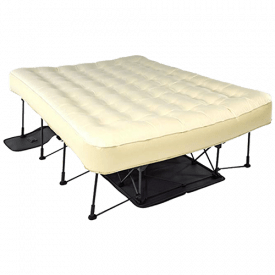
The Ivation EZ-Bed Air Mattress with Frame & Rolling Case inflates and deflates quickly and easily. The air mattress has a coil design to create a supportive night’s sleep.
Contender
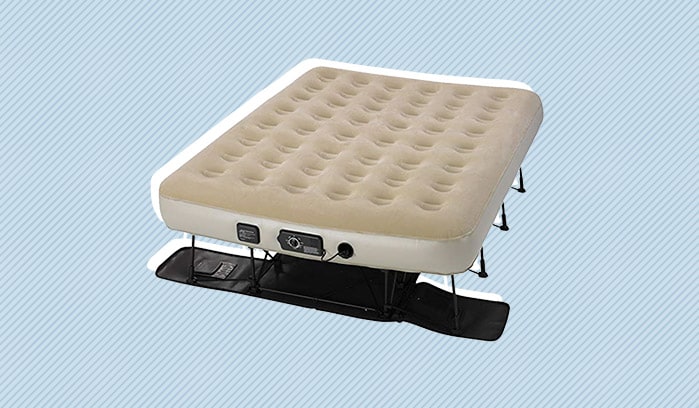
Serta EZ Air Mattress with Never Flat Pump
Pros:
- The patented inflation system inflates or deflates the air mattress in under four minutes.
- The NeverFlat pump monitors air pressure and automatically adds more air to the bed if it’s falling flat, which helps sustain a supportive night’s sleep.
- The frame unfolds automatically while the pump inflates the air mattress, so assembly is very easy.
- When not in use, the frame folds down for easy and fairly compact storage.
Cons:
- This is an expensive product, and it won’t be accessible to all budgets.
- The air mattress might start to hold air less well over time.
Serta EZ Air Mattress with Never Flat Pump
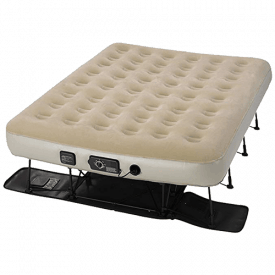
The Serta EZ Air Mattress with NeverFlat Pump inflates and deflates quickly and stores easily. The NeverFlat pump automatically adds more air when necessary to ensure a supportive night’s sleep.
Also Consider
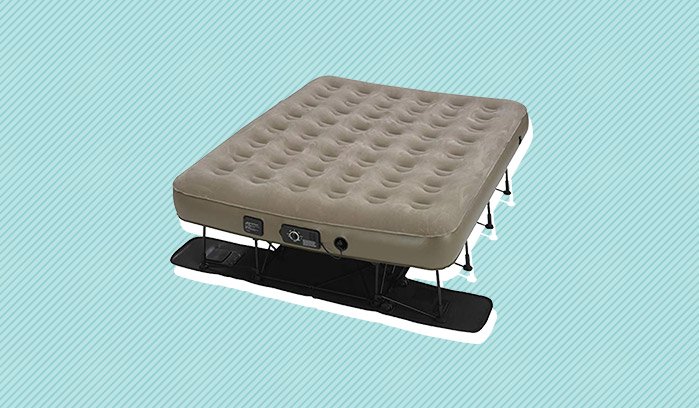
Insta-Bed Ez Raised Air Mattress with NeverFLAT
Pros:
- The NeverFLAT system automatically adds some extra air after the first round of inflating to ensure a supportive sleep.
- The included pump is designed to inflate or deflate the air mattress in under four minutes.
- The frame automatically unfolds while the bed inflates, so most of the system sets itself up on its own.
Cons:
- This is a very pricey air mattress with frame, so it won’t be available to everyone.
- The manufacturer recommends inflating the bed at least an hour before using it, which requires some advance planning.
Insta-Bed EZ Raised Air Mattress with NeverFlat

Both the frame and the air mattress of the Insta-Bed Ez Raised Air Mattress with NeverFlat set up automatically, which makes setup a breeze. The NeverFLAT pump automatically adds air if the mattress starts to deflate while you’re sleeping.
Best Bargain
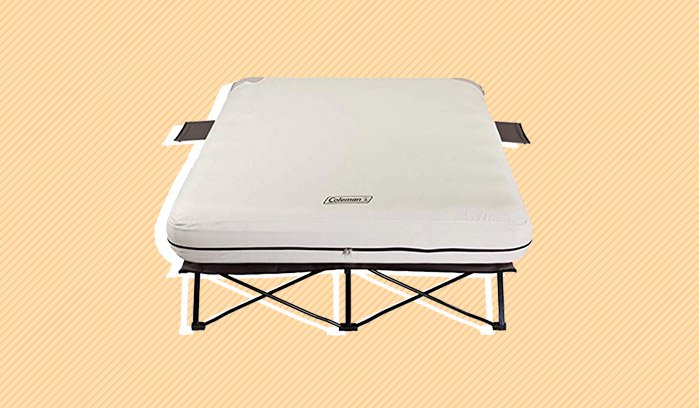
Coleman Camping Cot, Air Mattress, and Pump Combo
Pros:
- The three-piece set includes an air mattress, a cot frame with side tables, and a battery-operated pump. The steel frame is designed to hold up to 600 pounds.
- Compared to other air mattresses with frames, this is a relatively budget-friendly option. In addition to the three pieces mentioned above, it also comes with a carry bag for easy storage.
- The air bed has a coil construction that helps ensure a sturdy, supportive night’s sleep.
- The two side tables pull out to provide an accessible storage space for cups, books, glasses, and so on.
Cons:
- The frame and air bed together are fairly heavy, so it’s not super easy to transport the bed.
- The air pump doesn’t seem to be super high quality, so you might want to purchase another one.
Coleman Camping Cot, Air Mattress, and Pump Combo
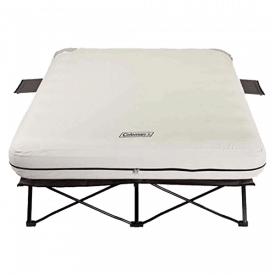
The relatively budget-friendly ColemanCamping Cot, Air Mattress, and Pump Combo features two side tables for easily stashing cups, books, glasses, and so on. The sturdy design can hold up to 600 pounds and features a coil construction for a supportive night’s sleep.
How We Picked
To settle on our selection for this roundup of air mattresses with frames, we focused on the following features.
Ease of Setup
Air mattresses with frames are meant to make life easier, but their setup can sometimes be a hassle. We prioritized options that are easy to use, whether through fast inflation and deflation, automatic inflation, inflation sensors that automatically pump up the air mattress if it starts to deflate, or all of the above. Each of the options on this list should be fairly easy to install.
Extra Features
Each of the options here provides an air mattress and a matching frame. Beyond that, we also included options with extra features such as side tables, automatic inflation technology, anti-slip designs, carrying cases, and/or other extra features. Each of the options on this list should provide highly functional design.
Included Items
Air mattresses with frames tend to be expensive, so it’s fair to expect that everything you need to set up these items will be included in your purchase. For that reason, we focused on options that include (at a minimum) an air mattress, a frame, and an air mattress pump. You should be able to set up each of these options right out of the box without purchasing anything else (except for maybe some air pump batteries).
Sleepopolis Buying Tips
Still trying to settle on the best air mattress with a frame? Then take the following into account:
- Budget. Air mattresses with frames can range in price from around $100 to over $300. That’s a big range, so clarifying your budget could help you rule out a lot of options.
- Sizing. Air mattresses with frames are available in a variety of sizes, including Twin and Queen air mattresses. It’s important to know what size you’re looking for before purchase. Also note that smaller sizes cost less than larger ones.
- Storage. The amount of room that you can devote to storing an air mattress and frame could affect the dimensions that you’re able to purchase. Also consider whether it’s essential to get a product that comes with its own storage case.
No matter whether you’re looking to host guests comfortably in your home or sleep more luxuriously in a tent, an air mattress with frame can be a lifesaver. To find the best one for you, think about your budget, your functional needs, and mattress sizing. Happy shopping!
FAQs
Is an air bed good for daily use?
As a general rule, air mattresses aren’t designed for long-term use. While it should be fine to sleep on an air mattress for several days or so, you might find that sleeping on an air-mattress long-term leads to back pain. That’s because air mattresses don’t usually do a great job of accommodating different sleeping positions and promoting spinal alignment.
How do you sleep comfortably on an air mattress?
There are several strategies you can use to sleep comfortably on an air mattress. Inflate the mattress to your comfort preferences, make sure you use sheets and bedding (like you would on a normal mattress), use a pillow that’s suited to your preferred sleep position, and/or place the air mattress near a wall so you can prop yourself up while reading or hanging out in bed. You might also consider adding a mattress topper to the top of the air mattress for extra comfort.
How can I make my air mattress less noisy?
Air mattresses are known for making squeaks or other noises when a sleeper moves around. But a few strategies might help. For instance, you could place a non-slip blanket between the air mattress and its frame, place a mattress topper on top of the mattress, and/or use thick bedding to help muffle any sounds.
